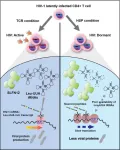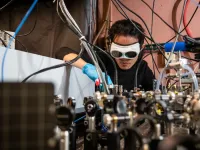(Press-News.org) Washington, DC – Fungi produce metabolites that humans have used to improve health. For example, they secrete penicillin, which is then purified and used as an antibiotic for humans, leading to the development of many other antibiotics. However, the ecology of fungal metabolites in microbial communities is not well understood. In a new study, researchers use cheese rinds to demonstrate that fungal antibiotics can influence how microbiomes develop. The study is published in mBio, an open-access journal of the American Society for Microbiology.
“My lab is interested in how fungi shape the diversity of microbial communities where they live. Fungi are widespread in many microbial ecosystems, from soils to our own bodies, but we know much less about their diversity and roles in microbiomes compared to more widely studied bacteria,” said principal investigator of the new study Benjamin Wolfe, PhD, associate professor in the Department of Biology at Tufts University. His lab studies how fungi interact with other microbes in microbial communities, with a focus on fungal bacterial interactions. “To study the ecology of fungi and their interactions with bacteria, we use cheese rinds as a model microbial ecosystem to understand these basic biology questions,” said Wolfe.
Cheese rinds are microbial communities that form on the surfaces of naturally aged cheeses such as Brie, Taleggio and some Cheddars. The fuzzy and sometimes sticky layers on the surfaces of these cheeses are communities of microbes that develop as the cheese is aged. They slowly decompose the cheese curd as they grow on the surface and produce aromas and pigments that give each artisan cheese unique properties.
Several years ago, a cheesemaker reached out to Wolfe with a mold problem: A mold was becoming abundant on the surfaces of the cheesemaker’s cheeses and was disrupting the normal development of their rind. It appeared as though the rinds were disappearing as the mold invaded their cheese cave. This mold invasion provided a perfect opportunity for Wolfe and his colleagues to study the ecology, genetics and chemistry of fungal-bacterial interactions.
Wolfe’s team began a collaboration with Nancy Keller's lab at the University of Wisconsin to try to figure out how this mold was impacting the rind microbial community. They wanted to find out what the mold was doing to the rind microbes and what chemicals the mold may be producing that could disrupt the rind.
To conduct their study, the researchers first deleted a gene (laeA) in the Penicillium mold that is known to control the expression of chemicals that fungi can secrete into their environment. These compounds are called specialized or secondary metabolites. “We know that many fungi can produce metabolites that are antibiotics because we have used these as drugs for humans, but we know surprisingly little about how fungal antibiotics work in nature,” said Dr. Wolfe. “Do fungi actually use these compounds to kill other microbes? How do these antibiotics produced by fungi affect the development of bacterial communities? We added our normal and our laeA-deleted Penicillium to a community of cheese rind bacteria to see whether deleting laeA caused changes in how the community of bacteria developed.”
The researchers found that when they deleted laeA, most of the antibacterial activity of the Penicillium mold was lost. This was exciting because it allowed the researchers to narrow down specific regions of the fungal genome that might be responsible for producing the antibacterial compounds. They were eventually able to narrow it down to one class of compounds called pseurotins. These are metabolites produced by a range of fungi that have been shown to have interesting biological activities including immune system modulation, insect killing and bacterial inhibition.
The study is the first to show that pseurotins can control how bacterial communities living with that fungi grow and develop. The pseurotins produced by the Penicillium mold in cheese are strongly antibacterial and dramatically inhibited certain bacteria compared to others (the bacteria inhibited were Staphylococcus, Brevibacterium, Brachybacterium, and Psychrobacter, which are found on many artisanal cheeses). This caused a dramatic shift in the composition of the cheese rind microbiome in the presence of the Penicillium-produced pseurotins.
This study demonstrates that antibiotics secreted by fungi can control how microbiomes develop. Because many fungi produce similar metabolites in a range of other ecosystems, from the human microbiome to soil ecosystems, the researchers expect that these mechanisms of fungal-bacterial interactions are widespread.
“Our results suggest that some pesky mold species in artisan cheeses may disrupt normal cheese development by deploying antibiotics,” said Wolfe. “These findings allow us to work with cheesemakers to identify which molds are the bad ones and how to manage them in their cheese caves. It also helps us appreciate that every time we eat artisan cheese, we are consuming the metabolites that microbes use to compete and cooperate in communities.”
The study was funded by a CAREER award from the National Science Foundation (Grant # 1942063).
###
The American Society for Microbiology is one of the largest professional societies dedicated to the life sciences and is composed of 30,000 scientists and health practitioners. ASM's mission is to promote and advance the microbial sciences.
ASM advances the microbial sciences through conferences, publications, certifications, educational opportunities and advocacy efforts. It enhances laboratory capacity around the globe through training and resources. It provides a network for scientists in academia, industry and clinical settings. Additionally, ASM promotes a deeper understanding of the microbial sciences to diverse audiences.
END
An increasing number of Floridians agree that human actions are causing climate change, including a record number of Florida Republicans, according to a new survey from Florida Atlantic University. This finding reinforces the trend observed in the prior seven Florida Climate Resilience Surveys, conducted by FAU’s Center for Environmental Studies within the Charles E. Schmidt College of Science.
Three main messages emerge from this latest poll. First, climate change is no longer an effective partisan wedge issue. Virtually all respondents (90 percent) ...
WASHINGTON—Anzela Niraula, Ph.D., of the University of Washington in Seattle, won the Endocrine Society's 2023 Endocrine Images Art Competition for her image of the microglia mandala.
This contest celebrates the beauty of endocrine science, and entries were judged based on aesthetic value and significance to endocrine research.
Niraula’s image of the microglia won the grand prize this year out of more than 25 entries. The image shows microglia and POMC neurons in close proximity within the arcuate nucleus of the hypothalamus. Microglial regulation of POMC neurons holds significant implications ...
Researchers from University of International Business and Economics, University of Groningen, University of Cologne, and University of Chinese Academy of Sciences published a new Journal of Marketing article that examines the drivers of brand extension success.
The study, forthcoming in the Journal of Marketing, is titled “A Meta-Analysis of Brand Extension Success: The Effects of Parent Brand Equity and Extension Fit” and is authored by Chenming Peng, Tammo H.A. Bijmolt, ...
COLUMBUS, Ohio – Imagine you could travel to only 1% of the city where you live – areas that were easily accessible to other residents.
That’s the situation for manual wheelchair users traveling by public buses in Columbus, a first-of-its-kind study finds. The situation for those with powered wheelchairs is only somewhat better – the study found they have access to about 25% of the areas available to the general bus ridership.
But the main problem isn’t with the bus system itself – the key obstacle is with the sidewalks and other infrastructure that wheelchair users need to get from ...
Brigham and Women’s Hospital, a founding member of Mass General Brigham, today announces a historic $100 million gift from eminent biotechnology entrepreneur Gene Lay, MS, DVM, founder and CEO of BioLegend, Inc., through the Laygend Foundation. The landmark gift—the largest in the Brigham’s history—will establish The Gene Lay Institute of Immunology and Inflammation of Brigham and Women’s Hospital, Massachusetts General Hospital (MGH), also a founding member of Mass General Brigham, and Harvard Medical School (HMS). Vijay Kuchroo, DVM, PhD, an immunologist and principal investigator at the Brigham, will serve as inaugural director of the institute, which will be ...
Barcelona, Spain – 10 May 2023: A small randomised trial in patients with post-COVID syndrome has found that hyperbaric oxygen therapy promotes restoration of the heart’s ability to contract properly. The research is presented at EACVI 2023, a scientific congress of the European Society of Cardiology (ESC).1
“The study suggests that hyperbaric oxygen therapy can be beneficial in patients with long COVID,” said study author Professor Marina Leitman of the Sackler School of Medicine, Tel Aviv University and Shamir Medical Centre, Be'er Ya'akov, Israel. “We used a sensitive measure of cardiac function which is ...
An international study led by MELIS-UPF researchers from the Infection Biology and Molecular Virology laboratories has identified and characterized Schlafen 12 (SLFN 12) as a novel HIV restriction factor. SLFN 12 shuts down viral protein production and helps virus-infected cells to escape from anti-HIV therapy and immune responses. These findings pave the way for improving therapeutic strategies that aim to cure HIV infections.
Human Immunodeficiency Virus (HIV) infections, if left untreated, lead to the gradual destruction of the immune system, AIDS, in its final stages. Worldwide, some 650,000 ...
A new drug delivery system delivers an antioxidant directly to mitochondria in the liver, mitigating the effects of oxidative stress.
Mitochondria are microscopic organelles found within cells, and are well-known as the “powerhouse of the cell.” They are by far the largest producer of the molecule adenosine triphosphate (ATP), which provides energy to many processes in living cells. The process by which mitochondria synthesize ATP generates a large amount of reactive oxygen species (ROS), chemical groups that are highly reactive.
In a healthy cell, the ROS are controlled by the mitochondria; however, when this balance is lost, the excess ROS damages the mitochondria ...
With each breath, humans exhale more than 1,000 distinct molecules, producing a unique chemical fingerprint or “breathprint” rich with clues about what’s going on inside the body.
For decades, scientists have sought to harness that information, turning to dogs, rats and even bees to literally sniff out cancer, diabetes, tuberculosis and more.
Scientists from CU Boulder and the National Institute of Standards and Technology (NIST) have made an important leap forward in the quest to diagnose disease using exhaled breath, reporting that a new laser-based breathalyzer powered by artificial intelligence (AI) can detect COVID-19 in real-time with ...
May 10 2023, Utrecht (The Netherlands) - When corona patients themselves measure the oxygen level in their blood at home, this is well applicable through the general practice. This was shown in a study conducted by UMC Utrecht during the pandemic. The study showed that patients could easily perform the oxygen measurement themselves at home, they felt safe doing so and the number of GP or hospital visits did not increase. The researchers believe that - by enabling care close to home - patients experience more control and that it contributes to relieving caregivers and keeping ...




